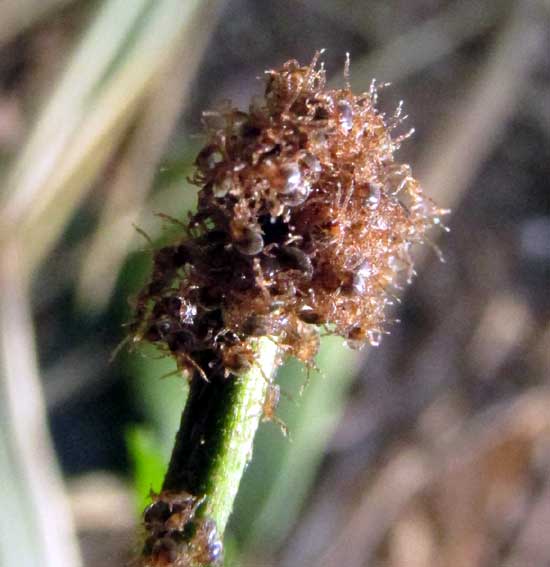Excerpts from Jim Conrad's
Naturalist Newsletter
from the December 4, 2016 Newsletter issued from Rancho Regenesis in the woods ±4kms west of Ek Balam Ruins; elevation ~40m (~130 ft), N20.876°, W88.170°; north-central Yucatán, MÉXICO
TICK "NEST" ENCOUNTER
Not long after going to sleep I awoke with my right leg burning like crazy. Burning and itching. Late that afternoon I'd taken a walk in the woods so I figured my leg had brushed against some kind of plant and now was suffering an allergic reaction. I got up and washed the leg with soap and water, hoping to remove whatever it was causing the misery, but it just got worse. With no electricity here, I was doing all this with a flashlight, so it was awhile before I noticed that tiny, black specks dotted my leg, and then it dawned on me: Ticks.
Sometimes I've seen dark-brown masses of extremely tiny ticks clumped along paths. Up North often they're called seed ticks, and hunters tell stories about brushing into such "nests," though they're not really nests, just masses, and watching hundreds if not thousands of the little monsters swarm up a leg like an expanding ink smudge. This must have happened to me on my late-afternoon walk.
I set about removing the tiny critters, but it wasn't easy. Their microscopic heads were embedded into my flesh and their bodies were too small to pluck out with tweezers, so all I could do was scratch them out with my fingernails. Usually that left a pinprick of blood oozing from the left-behind hole. Many were in places I couldn't see, so I just scratched blindly.
Eventually I remembered how I used to daub nail polish onto chiggers. That would stop up the chiggers' breathing holes, or spiracles, and the chiggers would suffocate and drop off. I didn't have nail polish or anything like that, but here at the rancho we do have lots of Aloe vera. I've always treated burns with Aloe vera's mucilaginous juice. I've read that the way the juice works is that when it dries it leaves behind a thin film that forms a barrier between the burn and the air, and somehow that keeps the burn from forming blisters, and maybe lessens the pain. Maybe that film would plug a tick's spiracles.
I whacked off an Aloe leaf and smeared its juice all over my leg. Immediately the burning and itching diminished a little, but not much. The next morning I couldn't find ticks where I'd smeared the juice, so maybe the treatment worked, or maybe I'd just done a good job scratching, which I'd done plenty of. When at dawn the Maya workers came to work I told them about my night of misery and they -- all having had their own tick experiences -- said that I had two more nights to go, because the burning and itching lasts for three days, and that's exactly the way it was. They also itched during the days, but it was the nights, about an hour after lying down, when the wretchedness reached a peak.
Well, this is all very interesting. For example, one question coming to mind is, were these minuscule ticks a certain dwarf species, or just baby ticks? Also, I wanted to see one of those brown blobs of massed-together tick bodies against which my leg must have brushed. My friend Gener told me that finding such blobs was no problem. They're all along the woodland trails they drive the cattle and burros along each morning, heading to the day's grazing grounds.
Gener took me to one such trail and about fifteen seconds after he started looking he found a blob. Gener explained that the blobs nearly always occur right along the trail, at about ankle height, at the tip of a bending-over plant stem or leaf, where they can easily board any mammalian leg happening to brush against it. Below, you can see the blob we found, showing up as a small, brownish, egg-shaped object at the tip of the dark weed stem rising vertically a little left of the picture's center, with the pea-size "nest" midway the picture's center and the middle of its top border:

Below, a close-up of the "nest" shows many tick bodies crammed together, each tick with its legs groping outward to be ready if anybody's leg makes itself available:

At the University of Rhode Island's TickEncounter.Org website I learn that my dust-particle-size ticks probably aren't a dwarf species, but rather immature ticks. As the site says, "All ticks come in small, medium, and large sizes; officially these life stages are termed larva, nymph and adult." Apparently the ticks in our pictures are freshly hatched larvae. Though larval ticks sometimes carry diseases, normally they do not. It's larger ticks in the later stages of development who acquire pathogens from infected hosts who pass along diseases.
Looking into the tick situation in the Yucatan I learn that here ten locally growing plants have been identified with tick-killing properties, and some of those species are common here at the ranch. The most commonly found is a foul-smelling, rank weed in the gardens, a knee-high member of the Pokeweed Family sometimes known as Guinea-hen Root or Anamú, Petiveria alliacea, shown at www.backyardnature.net/yucatan/anamu.htm
The only species name given for ticks in the Yucatan in a 2007 research paper on the matter, by Rosado Aguilar and others, is Boophilus microplus, though I can't confirm that that's what we have here.
Whatever the case, nowadays I'm at work determining whether it does any good to crush Guinea-hen Root leaves on my legs when I go hiking in tick territory. I almost wrote that that plant's odor is nearly as bad as having the ticks, but then I remember my three nights of feverish scratching, I know that no odor can be worse than that.